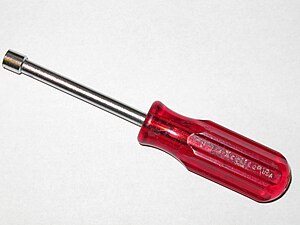Nut driver
This article includes a list of references, related reading, or external links, but its sources remain unclear because it lacks inline citations. (March 2013) |
A nut driver is a tool for tightening nuts and bolts. It essentially consists of a socket attached to a shaft and cylindrical handle and is similar in appearance and use to a screwdriver. They generally have a hollow shaft to accommodate a shank onto which a nut is threaded. They are typically used for lower torque applications than wrenches or ratchets and are especially popular in the electronics industry.
Variations include T-shaped handles for providing the operator with a better grip, ratcheting handles, sockets with recessed magnets for holding fasteners, and flex shafts for bending around obstructions.
A spinner handle is a shaft and handle with a drive fitting—most commonly ¼"—at the end for attaching interchangeable sockets. This allows one to use a single handle with a number of sizes instead of having a separate nut driver for each size. However, a spinner lacks the benefit of a hollow shaft; thus, a common alternative system is a single handle with interchangeable shafts in each size.
See also
References
- Brown, Sheldon (July 1982). "Tool Tips: Nutdrivers". Bicycling. Retrieved 2010-01-19.
- Sears Canada. "Workshop Guides: Glossary". Retrieved 2010-04-08.
- Klein Tools. "Proper Use and Care of Hand Tools: Wrenches". Retrieved 2010-04-21.

